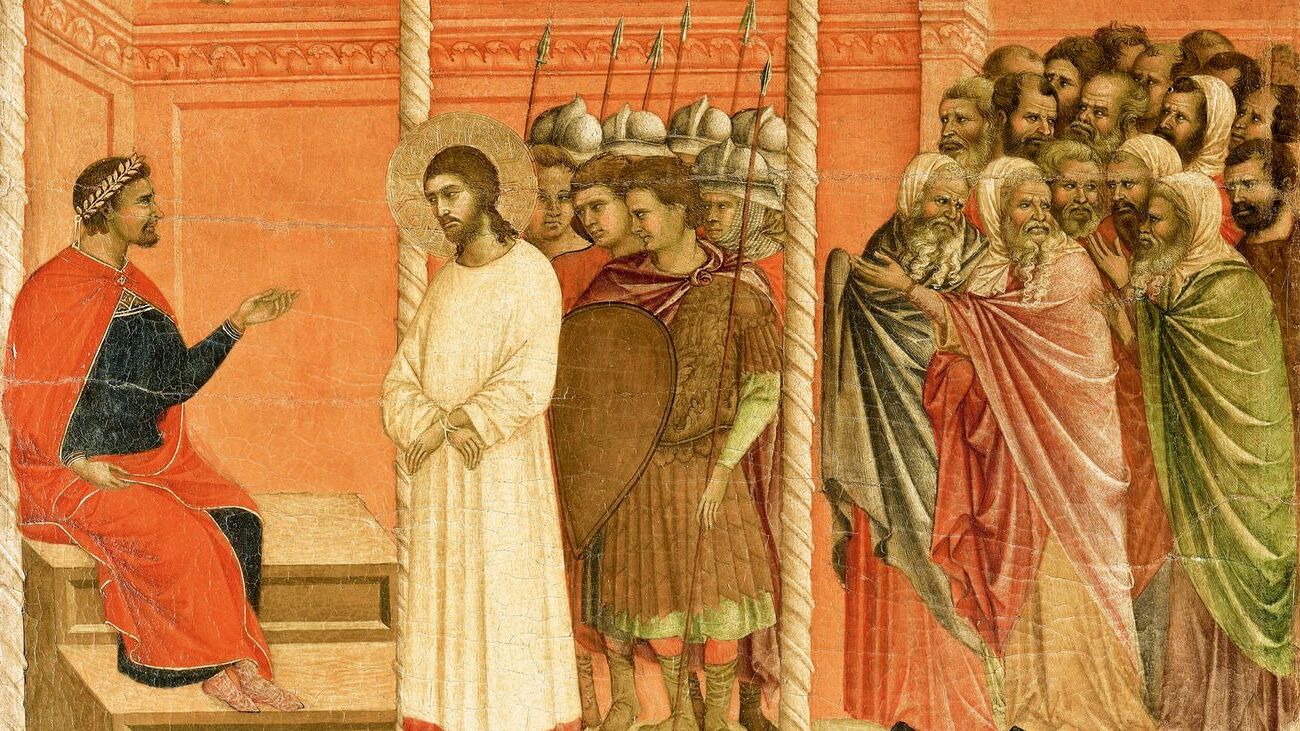
Who was Pontius Pilate? Pontius Pilate, a name etched in history, was the Roman governor of Judea from 26 to 36 AD. Known for his role in the trial and crucifixion of Jesus Christ, Pilate's decisions have sparked debates for centuries. His tenure was marked by tension between Roman authority and Jewish customs. Pilate's actions, often seen as controversial, provide a glimpse into the complexities of Roman rule in ancient Judea. From his interactions with local leaders to his ultimate fate, Pilate's story is a blend of political maneuvering, cultural clashes, and historical significance. Dive into these 34 facts to uncover more about this enigmatic figure.
Key Takeaways:
- Pontius Pilate was a Roman governor of Judea known for his role in Jesus' trial. He faced pressure, made controversial decisions, and his legacy continues to impact language and historical debates.
- Pilate's actions had a lasting impact on Roman-Jewish relations and the spread of Christianity. His name has even entered modern language, reflecting his enduring historical significance.
Who Was Pontius Pilate?
Pontius Pilate is a name that echoes through history, primarily known for his role in the trial and crucifixion of Jesus Christ. But there's more to this Roman governor than just that infamous event. Let's dive into some fascinating facts about him.
-
Roman Governor: Pilate served as the Roman governor of Judea from 26 to 36 AD. His main job was to maintain order and collect taxes.
-
Equestrian Rank: He belonged to the equestrian order, a social class just below the senatorial rank in ancient Rome.
-
Appointed by Tiberius: Emperor Tiberius appointed Pilate to his position. This was a significant role, given the volatile nature of Judea.
-
Praefectus: His official title was "praefectus," which means he was a military governor with both civil and judicial powers.
Pilate's Role in the Trial of Jesus
Pilate's involvement in the trial of Jesus is perhaps his most well-known act. This event has been depicted in countless works of art, literature, and film.
-
Reluctant Judge: According to the Gospels, Pilate was reluctant to sentence Jesus to death. He found no fault in him.
-
Hand Washing: Pilate famously washed his hands in front of the crowd, symbolizing that he did not want to be responsible for Jesus' death.
-
Inscription on the Cross: He ordered the inscription "INRI" (Iesus Nazarenus Rex Iudaeorum) to be placed on Jesus' cross, meaning "Jesus of Nazareth, King of the Jews."
-
Pressure from the Crowd: Pilate ultimately gave in to the crowd's demands for crucifixion, fearing a riot.
Pilate's Governance and Policies
Pilate's rule over Judea was marked by several controversial decisions and policies that often put him at odds with the local Jewish population.
-
Military Standards: He introduced Roman military standards bearing the image of the emperor into Jerusalem, which angered the Jews.
-
Aqueduct Construction: Pilate used funds from the Temple treasury to build an aqueduct, leading to protests and unrest.
-
Violent Suppression: He was known for his harsh methods in quelling uprisings, including the use of violence.
-
Golden Shields Incident: Pilate placed golden shields in Herod's palace, which the Jews saw as an affront to their religious beliefs.
Pilate in Historical Texts
Pilate's actions and character have been recorded by various historical sources, providing a broader picture of his life and rule.
-
Philo of Alexandria: Philo described Pilate as inflexible, stubborn, and cruel.
-
Josephus: The Jewish historian Josephus wrote about Pilate's conflicts with the Jews and his eventual removal from office.
-
Tacitus: The Roman historian Tacitus mentioned Pilate in his Annals, noting his role in Jesus' execution.
-
Gospels: The New Testament Gospels provide the most detailed accounts of Pilate's interactions with Jesus.
Pilate's Downfall and Later Life
Pilate's career did not end well. His harsh governance eventually led to his downfall.
-
Samaritan Uprising: A violent suppression of a Samaritan uprising led to complaints being sent to Rome.
-
Recalled to Rome: Pilate was recalled to Rome by Emperor Tiberius to answer for his actions.
-
Exile or Suicide: Some sources suggest Pilate was exiled, while others claim he committed suicide.
-
Saint in Some Traditions: Interestingly, some Christian traditions, particularly the Ethiopian Orthodox Church, regard Pilate as a saint.
Pilate in Art and Culture
Pilate's legacy has permeated various forms of art and culture, reflecting his complex and controversial role in history.
-
Medieval Art: Pilate appears in numerous medieval artworks, often depicted washing his hands.
-
Literature: He is a character in many literary works, including Dante's "Divine Comedy" and Bulgakov's "The Master and Margarita."
-
Film and Television: Pilate has been portrayed by numerous actors in films like "The Passion of the Christ" and "Jesus Christ Superstar."
-
Music: His story has inspired musical compositions, including Bach's "St. Matthew Passion."
Pilate's Legacy
Pilate's legacy is a mix of historical fact and legend, making him a figure of enduring fascination.
-
Archaeological Evidence: The Pilate Stone, discovered in 1961, is an inscription that confirms his existence and role as governor.
-
Pilate's Wife: According to tradition, Pilate's wife, Claudia Procula, had a dream about Jesus and warned her husband not to harm him.
-
Symbol of Authority: Pilate often symbolizes the struggle between political power and moral responsibility.
-
Easter Narratives: His role in the Easter story makes him a central figure in Christian theology.
Pilate's Name in Modern Usage
Pilate's name has found its way into modern language and expressions, often carrying a negative connotation.
-
"Washing One's Hands": The phrase "washing one's hands of something" originates from Pilate's act of washing his hands during Jesus' trial.
-
Pilate Syndrome: This term describes leaders who avoid responsibility by shifting blame to others.
-
Pontius Pilate Award: Some organizations give this satirical award to individuals who shirk responsibility.
Pilate's Historical Impact
Pilate's actions had a lasting impact on both Roman and Jewish history, influencing events long after his death.
-
Jewish-Roman Relations: His harsh policies contributed to the growing tensions between Jews and Romans.
-
Christianity's Spread: The crucifixion of Jesus, overseen by Pilate, became a pivotal event in the spread of Christianity.
-
Historical Debates: Scholars continue to debate Pilate's motivations and character, making him a subject of ongoing historical interest.
Pontius Pilate's Legacy
Pontius Pilate's story is a mix of history, legend, and mystery. Known for his role in Jesus' trial, Pilate's decisions have sparked debates for centuries. His rule in Judea was marked by tension, as he struggled to balance Roman authority with local customs. Pilate's infamous act of washing his hands symbolized his attempt to distance himself from Jesus' fate, yet it forever linked him to one of history's pivotal moments.
Archaeological finds, like the Pilate Stone, provide glimpses into his life, but many questions remain. Was he a ruthless governor or a man caught in a difficult position? Pilate's legacy continues to intrigue scholars and the public alike. His story reminds us how one person's actions can echo through time, shaping history in unexpected ways.
Frequently Asked Questions
Was this page helpful?
Our commitment to delivering trustworthy and engaging content is at the heart of what we do. Each fact on our site is contributed by real users like you, bringing a wealth of diverse insights and information. To ensure the highest standards of accuracy and reliability, our dedicated editors meticulously review each submission. This process guarantees that the facts we share are not only fascinating but also credible. Trust in our commitment to quality and authenticity as you explore and learn with us.


